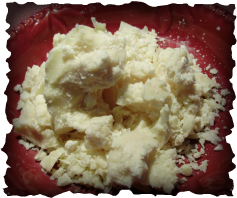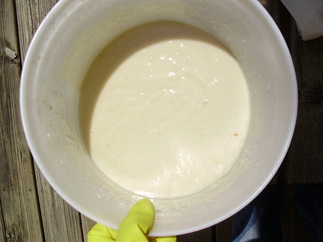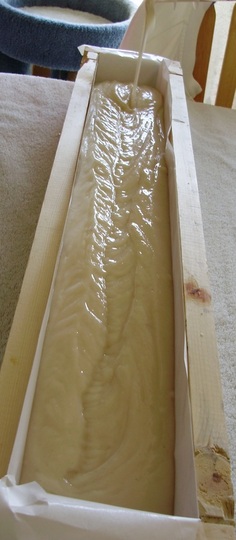Bar Soap Recipes and Basic Instructions
|
This page of our notebook will describe our process of making bar soap. All of our recipes are "cold processed" soaps. Because of the nature of working with raw ingredients, utmost caution is advised, especially when handling lye (sodium hydroxide). I have unfortunately been burned quite a few times because of my lack of said caution. So from personal experience, I warn you to be careful. Always wear protective gloves, long sleeves, something on your feet, (in case it spills), and perhaps eye protection. Be careful not to inhale the fumes of the water and lye mixture- or you'll be coughing for a bit. Just use common sense and be aware of your surroundings.
|
|
|
Soap.making.diyFollow these photos for a step-by-step process. These steps easily apply for any type of cold-process soap, and can be customized to meet whatever your personal tastes might be. Be careful, and if you have any trouble at'all, please gimme a shout out on our howdy page.
HAVE FUN!! |
. . . Just use common sense
Aside from the necessary precautions, soap making is a lot of fun! The options are virtually endless, considering the diversity of oils available. Almost any animal fat or vegetable oil can be used. My favorites include lard and tallow, sunflower oil, coconut oil, cocoa butter, olive oil, and lanolin. Some oils or waxes, such as sweet almond oil and lanolin, are referred to as "superfatting agents" and are added at trace (just before pouring it into the mold) to provide the ultimate moisturization. Others like Sunflower oil are rich in nutrients like Vitamin E. Neem oil is said to cure dandruff, so naturally, you'd add that to a shampoo bar. Wheat Germ oil, also rich in Vitamin E, can relieve itchiness
due to excema and psoriasis, cure scars and remove stretch marks.
due to excema and psoriasis, cure scars and remove stretch marks.
A thought on chocolate...
|
Soaps can be just plain old-fashioned, like our Pioneer and Castile soap, and used for Living History encampments and demonstrations. Great for camping, too, since our soaps are made with biodegradable natural oils and animal fats that are safe for run-off. Other soap bars are simply fun to make, like the Cocoa Mint.
I mean, who can resist chocolate? The cocoa butter is best when unrefined, so it retains it's natural chocolate-y aroma and creamy color. Some soap-makers prefer the refined stuff that is odorless and bleached white, but who wants that? I have used different fragrances with it, and it smells just fine, I am pleased to report. |
Enough said . . . let's make soap!
|
Each time you make soap,
you will need some basic materials:
|
|
Pioneer Soap

Dating back to the early 19th century, our Pioneer Soap is made with tallow (natural beef or deer fat). Unscented and a natural creamy white, this very hard and long-lasting bar soap produces a rich, creamy lather even in cold water. It's great for hunters who don't want their human scent in the woods, or for folks who prefer a non-fragrant soap. Also great for hand milling, since you can then add your favorite essential oils, herbs/ spices, and colorants.
(Just be sure to follow a guide for hand-milling soaps, if that's what you'd like to do. Some soaps need to be grated while the soap bar is still "fresh", like this one. Do your homework, and I'm sure it'll turn out great.)
|
To make 1 lb. of soap:
16 oz. tallow, rendered and clarified 4-6 fl. oz. water 2.07-2.13 oz. lye |
To make 4 lbs. of soap:
64 oz. tallow, rendered and clarified 16- 24 fluid oz. water 9.01- 9.31 oz. lye |
|
I. Using an accurate scale, carefully measure the ingredients. Pour water into bucket. Slowly add lye. Face away so you don't breathe the fumes, and stir to dissolve completely. This step is crucial, since if not dissolved properly, it will ruin the entire batch of soap. It should be a cloudy white liquid with lots of steam. Oh- make sure the surface you are working on is heat-proof. The chemical reaction between lye and water gets hot fast and takes awhile to cool. Keep stirring, and with the other hand, pour in the tallow. This is where it's nice to have a friend helping. Continue stirring with the spoon, or use the stick blender to mix thoroughly, being extremely cautious not to splash it.
|
II. When it comes to trace, that is, when it reaches the consistency of yogurt or sour cream, immediately pour into mold. Use a rubber spatula to get it all out. Set the bucket and utensils aside to wash out later, usually about a day so that you don't get a rash on your hands and arms. Been there, done that. Or leave your gloves on and rinse with hot water immediately. That way you can make another batch right away if you wish.
|
|
III. When it comes to trace, that is, when it reaches the consistency of yogurt or sour cream, immediately pour into mold. Use a rubber spatula to get it all out. Set the bucket and utensils aside to wash out later, usually about a day so that you don't get a rash on your hands and arms. Been there, done that. Or leave your gloves on and rinse with hot water immediately. That way you can make another batch right away if you wish.
|
Soap... always a necessity.
|
IV. Allow the soap to cure overnight (or 24 hours) and slice into bars. (About 3/4 inch thick is good.) Set them apart on a shelf lined with newspaper to cure undisturbed for 2-4 weeks and voila!
You have just made your very own homemade soap. Now knock yourself out and do some laundry!!
You have just made your very own homemade soap. Now knock yourself out and do some laundry!!
Basic Soap Recipe

This is our base recipe that we use for most of our soaps. You can customize this soap with essential/ fragrance oils, colorants, and exfoliants. Yields: 4 lbs.
32 oz. tallow, rendered for use, warm to soften
20 oz. coconut oil
12 oz. sunflower oil
16-24 oz. distilled or spring water
9.01-9.31 oz. lye
1 oz. essential/ fragrance oil
1 tsp. oxide or mica for color (or more depending on desired effect)
Use the photos above for specific guidelines. Otherwise, here are your basic steps:
I. Measure water into bucket and slowly add lye. Stir to dissolve.
II. Add tallow and oils. Stick blend to slight trace.
III. Add essential/ fragrance oil. Stick blend thoroughly. FYI: Some essential oils can speed trace. Just watch and you might need to move quick at this point to pour into your mold in time.
IV. Add oxide or mica and blend completely.
V. Pour into prepared mold. Use a spatula to get it all out. Don't waste any! Allow to cure overnight.
VI. The next day, remove hard soap from mold and peel off freezer paper. Slice into bars. Cure on newspaper lined shelf for 2-4 weeks for best results. Now give yourself a pat on the back. Good job!
32 oz. tallow, rendered for use, warm to soften
20 oz. coconut oil
12 oz. sunflower oil
16-24 oz. distilled or spring water
9.01-9.31 oz. lye
1 oz. essential/ fragrance oil
1 tsp. oxide or mica for color (or more depending on desired effect)
Use the photos above for specific guidelines. Otherwise, here are your basic steps:
I. Measure water into bucket and slowly add lye. Stir to dissolve.
II. Add tallow and oils. Stick blend to slight trace.
III. Add essential/ fragrance oil. Stick blend thoroughly. FYI: Some essential oils can speed trace. Just watch and you might need to move quick at this point to pour into your mold in time.
IV. Add oxide or mica and blend completely.
V. Pour into prepared mold. Use a spatula to get it all out. Don't waste any! Allow to cure overnight.
VI. The next day, remove hard soap from mold and peel off freezer paper. Slice into bars. Cure on newspaper lined shelf for 2-4 weeks for best results. Now give yourself a pat on the back. Good job!
Castile Soap

Lemon Balm on top, Castile on bottom
Castile soap has been used for hundreds of years. Named for the Kingdom of Castile in Northern Spain, this very hard bar was once used historically for carving intricate designs. Yield: 4 lbs.
"In Greece, olive oil has been used as a topical skincare agent for many centuries. Olive oil is a powerful antioxidant that contains the vitamins E and A, as well as the monounsaturated fatty acids that make it an anti-inflammatory." -LiveStrong.com
32 oz. olive oil
32 oz. tallow, rendered for use, warm to soften
16-24 oz. distilled or spring water
8.12-8.39 oz. lye
I. Measure water into bucket. Slowly add lye, stirring to dissolve completely.
II. Add olive oil and tallow. Stick blend to trace.
III. Pour into prepared mold. Use a spatula. That's all there is to it! Super easy, huh? You're catching on now.
"In Greece, olive oil has been used as a topical skincare agent for many centuries. Olive oil is a powerful antioxidant that contains the vitamins E and A, as well as the monounsaturated fatty acids that make it an anti-inflammatory." -LiveStrong.com
32 oz. olive oil
32 oz. tallow, rendered for use, warm to soften
16-24 oz. distilled or spring water
8.12-8.39 oz. lye
I. Measure water into bucket. Slowly add lye, stirring to dissolve completely.
II. Add olive oil and tallow. Stick blend to trace.
III. Pour into prepared mold. Use a spatula. That's all there is to it! Super easy, huh? You're catching on now.
Cocoa Mint

This one takes a little more thought. But I think after you've gone through the last few recipes, you are ready to tackle this favorite soap. We'll be using the Base Recipe and customizing it. Warning: your kitchen will smell like an Andes Mint.
Can you handle it?
"The health benefits of peppermint oil include its ability to treat indigestion, respiratory problems, headache, nausea, fever, stomach and bowel spasms and pain. Due to the presence of menthol, menthone and menthyl esters, peppermint and peppermint oil find wide applications in manufacture of soap, shampoo, ...toothpaste, chewing gum, tea and ice cream." -OrganicFacts.net
32 oz. tallow
20 oz. coconut oil
12 oz. sunflower oil
16-24 oz. water
9.01-9.31 oz. lye
1 oz. peppermint essential oil
6-8 oz. unrefined cocoa butter
1-2 Tbsp. cocoa powder (for color)
1 tsp. green oxide or 2-3 Tbsp. natural chlorophyll (found in the "health food" section)
I. Measure water into bucket. Slowly add lye, stir to dissolve.
II. Add tallow and oils. Stick blend to trace.
III. Add peppermint essential oil and cocoa butter. Stick blend thoroughly.
IV. Pour half the soap into one of your oil measuring containers.
VI. Pour the soap into your prepared mold. See the colors coming in layers? Allow to cure as before and when you slice it the next day, you should see a pleasant swirling effect. See photo. Note: Each bar will be different. That's only natural when you create handmade bar soap. Good work, chica!
Can you handle it?
"The health benefits of peppermint oil include its ability to treat indigestion, respiratory problems, headache, nausea, fever, stomach and bowel spasms and pain. Due to the presence of menthol, menthone and menthyl esters, peppermint and peppermint oil find wide applications in manufacture of soap, shampoo, ...toothpaste, chewing gum, tea and ice cream." -OrganicFacts.net
32 oz. tallow
20 oz. coconut oil
12 oz. sunflower oil
16-24 oz. water
9.01-9.31 oz. lye
1 oz. peppermint essential oil
6-8 oz. unrefined cocoa butter
1-2 Tbsp. cocoa powder (for color)
1 tsp. green oxide or 2-3 Tbsp. natural chlorophyll (found in the "health food" section)
I. Measure water into bucket. Slowly add lye, stir to dissolve.
II. Add tallow and oils. Stick blend to trace.
III. Add peppermint essential oil and cocoa butter. Stick blend thoroughly.
IV. Pour half the soap into one of your oil measuring containers.
- To the soap in the bucket: Add cocoa powder. Stick blend thoroughly to a nice chocolate brown.
- To the soap in the oil bowl: Add green colorant. Stick blend carefully to a nice mint green.
VI. Pour the soap into your prepared mold. See the colors coming in layers? Allow to cure as before and when you slice it the next day, you should see a pleasant swirling effect. See photo. Note: Each bar will be different. That's only natural when you create handmade bar soap. Good work, chica!








